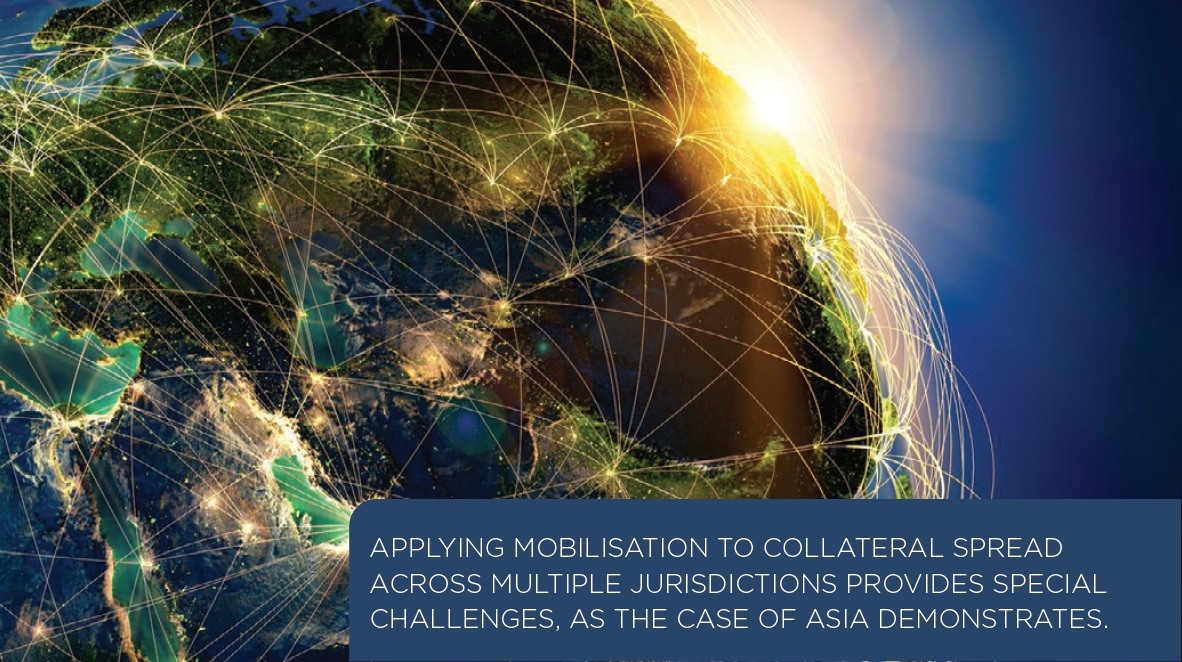Collateral mobilisation
Collateral mobilisation
An effective collateral transport solution means navigating multiple regulatory regimes and charting a path around – or through – a firm’s historical architecture.
Mobilisation is a hard concept to tie down. A handy definition from the ISSA collateral working group could be summarised thus: sourcing and pooling of collateral to minimise shortfalls by moving cash, securities, funds or commodities, across borders at the right time to cover exposures.
While participants may not agree on a precise definition of mobilisation, few would argue that 2020 saw an urgent need for the process. John Pucciarelli, head of industry and regulatory strategy at AcadiaSoft says the peak period of volatility during March and April 2020 saw some clients make 400 to 500 more calls per hour across the platform during peak times. “Across the community this amounted to 10,000 more calls to be processed per hour than in the months leading up to March.”
AcadiaSoft Analytics shows margin call volumes jumped from 1.06m in each of January and February to 1.78m in March. “Into May, daily volume levels continued to be 20% to 30% up from pre-crisis levels,” says Pucciarelli.
At MN, a Dutch pension fund group with Ä175m of AUM, the role of automation in facilitating mobilisation was starkly demonstrated during the volatility of early 2020. “We traditionally hold a lot of non-cash collateral with the banks delivering cash, but during that time we had to return much of this cash in some cases, and this required an efficient liquidity management process to get that back in on time,” says Dongyi Yin, senior collateral and securities lending manager at MN.
“During March and April it was really visible that there was more need for automation – even though our system performed well. There were times when you may have been getting twice the number of calls in some cases. You don’t want to have to submit a new file and have to scan for exceptions every hour. Our exception-based processing held up well, which showed it will be both future-proof and crisis-proof.”
The period demonstrated a general principal of operational infrastructures: people only notice them in a crisis. “In the normal days collateral management would not sound very attractive or important, but during those crisis times it proved the importance for the business. We felt proud that we could fully manage our margin obligations well,” says Yin.
Many firms lacking the mobilisation resources of MN and under pressure to mobilise quickly, had to meet calls with cash, creating big opportunity costs. “During February and March of 2020 when volatility and margin requirements spiked, cash balances increased 20-fold,” says Matt Wolfe, executive director of securities lending at Options Clearing Corporation (OCC).
On the sell side this exposed the gulf between firms that had built a robust mobilisation solution and those who hadn’t.
“Many banks seemed to focus on creating a more centralised source of collateral, so that when there is a spike in funding need, they can quickly pull from a centralised pool,” says Wolfe.
But many others have favoured a siloed model of collateral supporting separate obligations in futures, options, swaps, fixed income, equities and FX. Without the flexibility to shift assets to where they were most valuable, many participants fell back on cash.
“Certain participants were able to quickly increase the amount of equities or government securities on deposit so as not to maintain cash. By contrast, those who lacked collateral management systems designed to allow for the fast mobilisation of these resources just left cash on deposit. For that second group, there was a very high opportunity cost,” says Wolfe.
The mobilisation task ahead
What opportunities exist for the second group of firms to improve their mobilisation systems?
At MN, which only uses government bonds for collateral management, securities financing requirements are simpler than they would otherwise be. Nonetheless, the company has chosen to use the same provider for custody as for agency lending, in part because of the benefits around mobilisation and transport. “When it comes to
“Each collateral venue will have different structures for collateral eligibility. Standardising these approaches and building these models internally is a huge task."
- Rob Frost, Global Head of Product at Pirum.
The delay of the compliance deadline under UMR provided valuable breathing space for the roll out of the wider product, meanwhile.
“We have funds that need to be compliant next year. We have a working group focusing on this, evaluating the impact, assessing what systems we’ll need, what contracts and so on,” says Yin. Nonetheless, the delay was welcome. “It gives us room to breathe and more time over choice and implementation. We only want to implement this once so we need to get it right first time, rather than install something that we must be constantly fixing.”
For buy side clients, typically less experienced users of triparty, meeting UMR rules may be the first time they have encountered it.
Asia-Pacific focus
In APAC, the popularity of triparty has grown as buy side firms either fall in scope or prepare to be covered by UMR’s latest rules. “Those impacted by phase five tend to be the larger asset owner clients, who are often under pressure from their counterparties reluctant to accept a high degree of change in their mutual infrastructure,” says Katie Emerson, head of agency lending and collateral management sales, EMEA at J.P. Morgan. “Triparty may provide a simpler and more robust way to control a range of upstream collateral management needs including the management of margin calls”.
Achieving mobilisation means building connectivity and a process for selection, and ensuring the two combine. “Connectivity is a process of establishing the real-time ‘pipes and plumbing’ to consume the necessary data and process the outputs of the model. For selection you need the optimisation algorithm itself, the means of digitising collateral schedules and a system that checks eligibility rules and limits and exposures on a real-time basis,” says Rob Frost, global head of product at Pirum.
Applying mobilisation to collateral spread across multiple jurisdictions provides special challenges, as the case of Asia demonstrates.
Recent years have a seen a growth in inter-entity structures in the region. A global bank headquartered in London, for example, would see the benefits of distributing its balance sheet across entities in Hong Kong, Australia and Singapore, says Bhavna Haswani, vice president, APAC collateral services product manager at J.P. Morgan. “They understand that by moving balance sheet to Asia in this way, they get better funding benefits.”
Patchwork solutions
Given the heterogeneous patchwork of legal and regulatory regimes spanning the region, this is not always easy to achieve. CCPs are in their infancy; most still only accept cash as collateral. In many cases regulations governing onshore assets prevent them from being moved in this way, in which case a sub custodian may act as a local proxy. Even in Japan, the region’s second largest economy, there are specific local requirements around the pledging of onshore government bonds, limiting how banks with a presence in the region can use them.
As governments and regulators learn the benefits of cross-border asset movements to deepen market liquidity, large firms are proving valuable advocates for change. “There is a lot to be done, working with regional bodies to bring liquidity into the markets via standardisation and harmonisation,” says Haswani.
China is one example. The recent inclusion of China in FTSE and MSCI indices has increased demand from clients who wish to hold assets through Stock Connect, the collaboration between the Hong Kong, Shanghai and Shenzhen Stock Exchanges, or directly hold onshore bonds.
“Currently there is no mechanism to hold RMB bonds outside China. We have been working with a local bond depositary on an initiative to internationalise this market, by understanding how to bring cross-border collateral management programs,” says Haswani.
Title transfer not always possible
Limits on title transfer provide another challenge. China, Taiwan, India and Korea are all ID markets: there is no provision for a nominee structure, assets must be held by beneficial owners, so conventional transfers between beneficial owners under triparty, which typically require a transfer of title, are impossible.
Employing a pledge solution in Korea, J.P. Morgan uses a subcustodian as local proxy, drawing on its strong global network, ensuring a clear passage of assets to the non-defaulting party in the case of a default. “This way you get balance sheet efficiency and legal protection, even though the beneficial owner doesn’t change,” says Haswani.
Even when a practical pledge-based solution can be found, users take time to build confidence that their claim on assets is enforceable. “As part of the due diligence, you expect the recipient of pledge to take time to get comfortable that the pledge they have is legally enforceable. Otherwise for them there is not only risk regarding the collateral but also original counterparty risk that was meant to be mitigated by the collateral,” says O’delle Burke, collateral services global lead for product innovation and head of collateral services, APAC, at J.P. Morgan.
The importance of standardisation
Asia’s heterogeneity raises another question that plagues effective mobilisation in developed markets too – that of standardisation “Each collateral venue will have different structures for collateral eligibility. Standardising these approaches and building these models internally is a huge task, one that also incurs significant ongoing maintenance costs,” says Pirum’s Frost.
It illustrates a more general point about the need for flexibility in mobilisation. The process will take different forms, and use different channels, depending on where – and for whom – it is happening, concludes Karl Wyborn, chief commercial officer of Pirum.
“I think it’s important to realise that there is no single solution to mobilisation. But the good news is that this is not a binary challenge; even some relatively modest improvements in mobilisation can deliver meaningful P&L gains,” he says.
This article is part of our Collateral Management Guide 2021, and if you want to find more click here to download the whole whitepaper.
Found this useful?
Take a complimentary trial of the FOW Marketing Intelligence Platform – the comprehensive source of news and analysis across the buy- and sell- side.
Gain access to:
- A single source of in-depth news, insight and analysis across Asset Management, Securities Finance, Custody, Fund Services and Derivatives
- Our interactive database, optimized to enable you to summarise data and build graphs outlining market activity
- Exclusive whitepapers, supplements and industry analysis curated and published by Futures & Options World
- Breaking news, daily and weekly alerts on the markets most relevant to you





